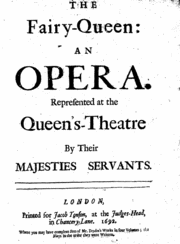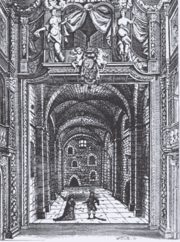The Fairy-Queen
2008/9 Schools Wikipedia Selection. Related subjects: Poetry & Opera
| Operas by Henry Purcell |
|---|
 Dido and Æneas (1689) |
The Fairy-Queen (Z.629) is a masque or semi-opera by Henry Purcell; a Restoration spectacular It was first performed on May 2, 1692 at the Queen's Theatre, Dorset Garden in London by the United Company. The libretto is an anonymous adaptation of William Shakespeare's wedding comedy A Midsummer Night's Dream. Presumably the author or at least co-author of the libretto is Thomas Betterton, the manager of Dorset Garden Theatre with whom Purcell worked regularly.
This assumption is based on an analysis of Betterton's stage directions. A collaboration between several playwrights is also feasible. Choreography for the various dances was provided by Josias Priest, who also worked on Dioclesian and King Arthur, and who was associated with Dido and Aeneas. Purcell did not set any of Shakespeare's text to music; instead he composed music for short masques in every act but the first. The play itself was also slightly modernized in keeping with seventeenth-century dramatic conventions, but in the main the spoken text is as Shakespeare wrote it. The masques are related to the play metaphorically, rather than literally. Many critics have stated erroneously that they bear no relationship to the play, but recent scholarship has shown that the opera, which ends with a masque featuring Hymen, the God of Marriage, was actually composed for the fifteenth wedding anniversary of William and Mary.
A letter describing the original performance shows that the parts of Titania and Oberon were played by children of eight or nine. Presumably other fairies were also played by children, which changes our perspective of the staging.
Context and analysis
Following the huge success of his operas Dioclesian (1690) and King Arthur (1691), Purcell composed The Fairy-Queen in 1692. Purcell's "First" and "Second Music" were played while the audience were taking their seats. The "Act Tunes" are played between acts, as the curtain was normally raised at the beginning of a performance and not lowered until the end. After Act I, each act commences with a short symphony (3-5 minutes).
The English tradition of semi-opera, to which The Fairy-Queen belongs, demanded that most of the music within the play be introduced through the agency of supernatural beings, the exception being pastoral or drunken characters. All the masques in The Fairy-Queen are presented by Titania or Oberon. Originally Act I contained no music, but due to the work's enormous success it was revived in 1693, when Purcell added the scene of the Drunken Poet and two further songs later on in the work; "Ye gentle spirits of the air" and "The Plaint". As said above, each masque is subtly related to the action in the play during that particular act in a metaphorical way. In this manner we have Night and Sleep in Act II, which is apt as that act of the play consists of Oberon's plans to use the power of the " love-in-idleness" flower to confuse various loves, and it is therefore appropriate for the allegorical figures of Secrecy, Mystery et al to usher in a night of enchantment. The masque for Bottom in Act III includes metamorphoses, songs of both real and feigned love, and beings who are not what they seem. The Reconciliation masque between Oberon and Titania at the end of Act IV prefigures the final masque. The scene changes to a Garden of Fountains, denoting King William's hobby, just after Oberon says "bless these Lovers' Nuptial Day". The Four Seasons tell us that the marriage here celebrated is a good one all year round and "All Salute the rising Sun"/...The Birthday of King Oberon". The kings of England were traditionally likened to the sun (Oberon = William. Significantly, William and Mary were married on his birthday, 4 November.). The Chinese scene in the final masque is in homage to Queen Mary's famous collection of china. The garden shown above it and the exotic animals bring King William back into the picture and Hymen's song in praise of their marriage, plus the stage direction bringing (Mary's) china vases containing (William's) orange trees to the front of the stage complete the symbolism.
The music
Written as he approached the end of his brief career, The Fairy-Queen contains some of Purcell's finest theatre music, as musicologists have agreed for generations. In particular, Constant Lambert was a great admirer; from it he arranged a suite and in collaboration with Edward Dent arranged the work to form the then new Covent Garden opera company's first postwar production. It shows to excellent effect Purcell's complete mastery of the pungent English style of Baroque counterpoint, as well as displaying his absorption of Italian influences. Several arias such as "The Plaint", "Thrice happy lovers" and "Hark how the echoing air" have entered the discographic repertory of many singers outside their original context.
The orchestra for The Fairy-Queen consists of two recorders, two oboes, two trumpets, kettledrums, strings and harpsichord continuo.
Performance history
Following Purcell's premature death, his opera Dioclesian remained popular until well into the eighteenth century, but the score of The Fairy-Queen was lost and only rediscovered early in the twentieth century. Other works like it fell into obscurity. Changing tastes were not the only reason for this; the voices employed had also become difficult to find. The list of singers below shows the frequent employment of the male alto, or countertenor, in the semi-opera, a voice which, after Purcell, essentially vanished from the stage, probably due to the rise of Italian opera and the attendant castrati. After that Romantic opera emerged, with the attendant predominance of the tenor. Until the early music revival, the male alto survived mainly in the ecclesiastical tradition of all-male church choirs and twentieth-century American vocal quartets.
However, Purcell's music (and with it The Fairy-Queen) was resuscitated by two related movements: a growing interest in Baroque music and the rise of the countertenor, led by pioneers such as Alfred Deller and Russell Oberlin. The former movement led to performances of long-neglected composers such as Purcell, John Dowland, John Blow and even George Frideric Handel, while the latter complemented it by providing a way of making such performances as authentic as possible as regards the original music and the composer's intentions (less true for Handel, where countertenors appear as castrati replacements). This has led to The Fairy-Queen's increased popularity, and numerous recordings have been made, often using period instruments. The format of the work presents problems to modern directors, who must decide whether or not to present Purcell's music as part of the original play, which uncut is rather lengthy. Savage calculated a length of four hours. The decision to curtail the play is usually taken together with the resolution to modernize to such an extent that the cohesion between music, text and action sketched above is entirely lost. A video of an English National Opera production of the work was released in 1995.
Roles
| Role | Voice type | Premiere cast, 2 May 1692 (Conductor: - ) |
|
|---|---|---|---|
| Drunken Poet | baritone | ||
| First Fairy | soprano | ||
| Second Fairy | soprano | ||
| Night | soprano | ||
| Mystery | soprano | ||
| Secrecy | countertenor | ||
| Sleep | baritone | ||
| Corydon | baritone | ||
| Mopsa | soprano/countertenor | ||
| Nymph | soprano | ||
| 3 Attendants to Oberon | 1 soprano, 2 countertenors | ||
| Phoebus | tenor | ||
| Spring | soprano | ||
| Summer | countertenor | ||
| Autumn | tenor | ||
| Winter | baritone | ||
| Juno | soprano | ||
| Chinese Man | countertenor | ||
| Chinese Woman, Daphne | soprano | ||
| Hymen | baritone | ||
| SATB Chorus: Fairies and Attendants. Typically, the chorus is used at the end of airs to provide a recapitulation of the main theme of the air, as well as at moments of particular dramatic grandeur, such as at the entry of Phoebus during Act IV. |
|||
Synopsis
Acts 1
The first scene set to music occurs after Titania has left Oberon, following an argument over the ownership of a little Indian boy. Two of her fairies sing of the delights of the countryside ("Come, come, come, come, let us leave the town"). A drunken, stuttering poet enters, singing "Fill up the bowl". The stuttering has led many to believe the scene is based on the habits of Thomas d'Urfey: however, it may also be poking fun at Elkanah Settle, who stuttered as well and was long thought to be the librettist, due to an error in his 1910 biography.
The fairies mock the drunken poet and drive him away.
Act 2
It begins after Oberon has ordered Puck to anoint the eyes of Demetrius with the love-juice. Titania and her fairies merrily revel ("Come all ye songsters of the sky"), and Night ("See, even Night"), Mystery ("I am come to lock all fast"), Secrecy ("One charming night") and Sleep ("Hush, no more, be silent all") lull them asleep and leave them to pleasant dreams.
Act 3
Titania has fallen in love with Bottom (now equipped with his ass's head), much to Oberon's gratification. A Nymph sings of the pleasures and torments of love ("If love's a sweet passion") and after several dances, Titania and Bottom are entertained by the foolish, loving banter of two haymakers, Corydon and Mopsa.
Act 4
It begins after Titania has been freed from her enchantment, commencing with a brief divertissement to celebrate Oberon's birthday ("Now the Night", and the abovementioned "Let the fifes and the clarions"), but for the most part it is a masque of the god Phoebus ("When the cruel winter") and the Four Seasons (Spring; "Thus, the ever grateful spring", Summer; "Here's the Summer", Autumn; "See my many coloured fields", and Winter; "Now Winter comes slowly").
Act 5
After Theseus has been told of the lovers's adventures in the wood, it begins with the goddess Juno singing an epithalamium, "Thrice happy lovers", followed by a woman who sings the well–known "The Plaint" ("O let me weep"). A Chinese man and woman enter singing several songs about the joys of their world. ("Thus, the gloomy world", "Thus happy and free" and "Yes, Xansi"). Two other Chinese women summon Hymen, who sings in praise of married bliss, thus uniting the wedding theme of A Midsummer Night's Dream, with the celebration of William and Mary's anniversary.
Selected recordings
- Alfred Deller, The Deller Consort, Stour Music Chorus (2 CDs) — (1972) — Harmonia Mundi
- John Eliot Gardiner, The English Baroque Soloists The Monteverdi Choir, (2 CDs) — 1982 — Archiv Produktion 419 221-2
- William Christie, Les Arts Florissants (2 CDs) — 1989 — Harmonia Mundi HMC 90 1308/0
- Roger Norrington, The London Classical Players, The Schütz Choir of London (2 CDs) — 1994 — EMI Classics 7243 5 55234 2 6
- Ton Koopman, Amsterdam Baroque Orchestra and Chorus, (2 CDs) — 1994 — Erato 98507
- Nikolaus Harnoncourt, Concentus Musicus Wien, Arnold Schoenberg Chor (2 CDs) — 1995 — Teldec Classics 4509-97684-2

